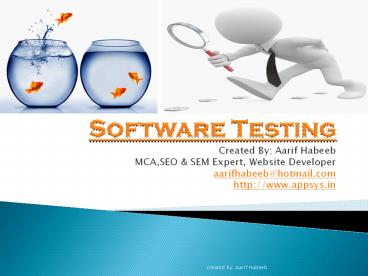software Testing PowerPoint PPT Presentation
Title: software Testing
1
Software Testing
- Created By Aarif Habeeb
- MCA,SEO SEM Expert, Website Developer
- aarifhabeeb_at_hotmail.com
- http//www.appsys.in
2
Agenda
- Introduction
- Goals of Testing
- Objectives of testing
- Levels of Testing
- Test Types
- VERIFICATION VALIDATION
- The testing process
- Testing phases
- Software Testing Difficulties
- Stages of Testing
- Conclusion
- Reference
- Question
- Contact us
3
Introduction
- What is Software Testing?
- Executing software in a simulated or real
environment, using inputs selected somehow.
4
Goals of Testing
- Detect faults
- Establish confidence in software
- Evaluate properties of software
- Reliability
- Performance
- Memory Usage
- Security
- Usability
5
Objectives of testing
- To understand testing techniques that are geared
to discover program faults - To introduce guidelines for interface testing
- To understand specific approaches to
object-oriented testing - To understand the principles of CASE tool support
for testing - Executing a program with the intent of finding an
error. - To check if the system meets the requirements and
be executed successfully in the Intended
environment. - To check if the system is Fit for purpose.
- To check if the system does what it is expected
to do.
6
Continue.Objective
- A good test case is one that has a probability of
finding an as yet undiscovered error. - A successful test is one that uncovers a yet
undiscovered error. - A good test is not redundant.
- A good test should be best of breed.
- A good test should neither be too simple nor too
complex.
7
Levels of Testing
- Unit Testing
- Integration Testing
- Validation Testing
- Regression Testing
- Alpha Testing
- Beta Testing
- Acceptance Testing
8
Test Types
- Functional tests
- Algorithmic tests
- Positive tests
- Negative tests
- Usability tests
- Boundary tests
- Startup/shutdown tests
- Platform tests
- Load/stress tests
9
VERIFICATION VALIDATION
- Verification - typically involves reviews and
meeting to evaluate documents, plans, code,
requirements, and specifications. This can be
done with checklists, issues lists, walkthroughs,
and inspection meeting. - Validation - typically involves actual testing
and takes place after verifications are
completed. - Validation and Verification process continue in
a cycle till the software becomes defects free.
10
The testing process
- Component testing
- Testing of individual program components
- Usually the responsibility of the component
developer (except sometimes for critical systems) - Tests are derived from the developers experience
- Integration testing
- Testing of groups of components integrated to
create a system or sub-system - The responsibility of an independent testing team
- Tests are based on a system specification
11
Testing phases
12
Stages of Testing
- Testing in the Small
- Unit Testing
- Feature Testing
- Integration Testing
- Unit Testing
- Tests the smallest individually executable code
units. - Usually done by programmers. Test cases might be
- selected based on code, specification, intuition,
etc. - Tools
- Test driver/harness
- Code coverage analyzer
- Automatic test case generator
13
- Integration Testing
- Tests interactions between two or more units or
- components. Usually done by programmers.
- Emphasizes interfaces.
- Issues
- In what order are units combined?
- How do you assure the compatibility and
correctness of externally-supplied components?
14
Software Testing Difficulties
- Most of the software testing literature equates
test - case selection to software testing but that is
just one - difficult part. Other difficult issues include
- Determining whether or not outputs are correct.
- Comparing resulting internal states to expected
states. - Determining whether adequate testing has been
done. - Determining what you can say about the software
when testing is completed. - Measuring performance characteristics.
- Comparing testing strategies.
15
Stages of Testing
- Testing in the Large
- System Testing
- End-to-End Testing
- Operations Readiness Testing
- Beta Testing
- Load Testing
- Stress Testing
- Performance Testing
- Reliability Testing
- Regression Testing
16
Conclusion
17
Reference
- www.appsys.in
- www.google.com
- www.wiki.com
- www.softwaretesting.com
18
Questions
19
Contact us
- Appsys Informatics Pvt Ltd
- info_at_appsys.in
- aarif_at_appsys.in
- 91-9829160120
- 0141-4020120
- www.appsys.in
20
Thank you

